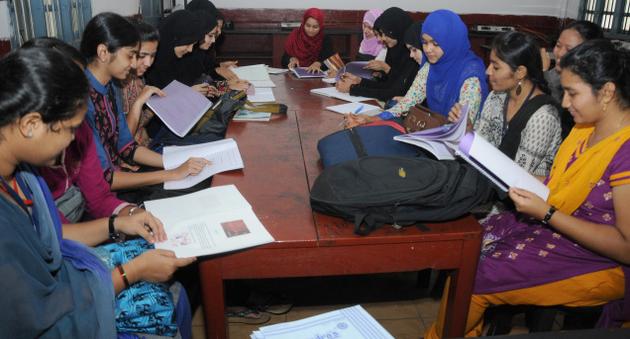
From the time it was instituted in the 1950s, the home science course has come a long way. Not just that, ARCHANA NATHAN finds that even our idea of who manages the home has changed, thereby not just women, even men should take up the home science course
“Train young girls to build up ideal families and motivate them to become agents of social change by stimulating their creative faculties, powers of reasoning and reflection.” If you search for a link to Bangalore University’s home science department, an outdated page appears featuring the above statement as the mission statement of the department.
The Bangalore University today does not offer home science as a course. A grand total of two colleges in the city of Bangalore are offering an opportunity to study home science, especially at the post-graduate level: Smt. V.H.D. Home Science Central Institute and Mount Carmel College. Of course at the pre-university level, there are a few others like Bishop Cottons Women’s College, a couple of Government colleges etc. But evidently, the number of home science colleges in the city is rather less for a course that is almost as old as the country.
It was the mission statement of BU that caught my eye. Why is building an ideal family only a girl’s responsibility, I wondered. But as I spoke to faculty members and heads of home science departments in the city, I understood the context for the mission statement.
When it was instituted, back in the 1950s in India, home science was envisaged as a course that would draw the woman from the domain of her home into academia and help her develop the skills she could use in a variety of spheres — most of which were considered purely hers back then. This included engaging with farming activities, learning about nutrition and planning the family’s diet, managing the resources in the family, understanding clothing and so on. “In the 1950s, as agriculture universities were being set up across the country, home science began as a department in each of them with the intention of making rural women a part of the farming process. In its urban avatar, it was modified to accommodate our lifestyle here and included subjects like food and nutrition to help the urban woman plan the diet for her family, a course called Human Development to help her cope with bringing her child up, marital relationships etc. A subject called Extension Education was added to help the urban woman communicate all that she has learnt to the people around her. So all home science students went to slums to tell them how important it is to plan one’s diet or about how to take care of children or prepare a low cost recipe. So home science met both the needs of the urban population as well as the individual’s,” explained Major. Dr. Shantha Maria, Dean, Home Science, Mount Carmel College.
“It was conceived for the first generation woman student. The intention was to empower her and strengthen the nucleus of the family,” said H. Rathna , Dean, Home Science, Smt. V.H.D. Home Science Central Institute.
Keeping the reasons for its genesis in mind, the question that needs to be asked is this: what kind of space does a department like home science occupy in today’s world? How has the course changed over time? And, lastly, why is it still a girl’s only course?
“Today, home science has become a career-oriented course. Nutrition, for example, is a much sought-after field for it has evolved much beyond the plate. Dieticians and nutrition experts are in demand in hospitals. A course like clothing has now morphed into something like fashion and apparel design, resource management now involves budgeting and finance. Along with interior design, we teach hospitality too. So it is about providing hands-on skills and preparing our girls for the job market,” says Dr. Shantha.
She added that students from diverse disciplines are opting for courses in home science. For instance, chemistry students are interested in Nutrition and psychology students in Human Development.
“Home science has actually completely changed. In classrooms here, we are talking about window displays, textile policy, how to dress a mannequin, art embroidery, how to set up a boutique, catering etc. Earlier, if the emphasis was on bringing up a child or taking care of a senior citizen, today there is an added dimension of a crèche or an old age home. We are preparing our girls to enter the care-giver’s market,” says Rathna.
However, in the race for the title of the most lucrative course, home science lags behind when compared to courses in information technology and finance. “Yes, but our numbers are still higher than the pure sciences,” added Dr. Shantha.
In its genesis, it might have been for the woman, but why does it continue to be a girl’s only course?
“Boys, even today think we learn cooking in our classes. Even if we do learn cooking, there are more chefs that are men than women. There are more tailors that are men than women. I don’t see why men can’t be encouraged to learn home science,” asks Mariyam Sakeena, a 1st year student of Food and Nutrition at V.H.D.
Members of faculty argue that since it began as a course for women, it has just remained that way. “But I do know of boys who have studied this course and excelled in it. If more departments need to be opened and if the course should be thrown open to boys too, the question that we must first ask is if the society is prepared to open their minds and opt for home science? The mindset needs to change first,” asserts Dr. Shantha.
Home science, therefore, seems to be stuck in people’s mind like it was in the past, though it has moved on long ago.
[“Source- thehindu”]

